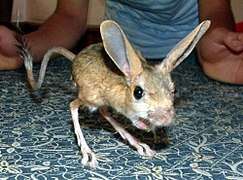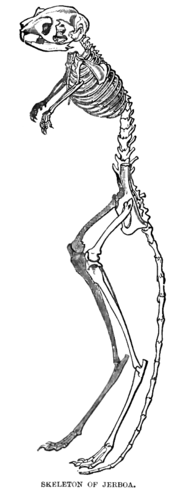Jerboa
| Jerboa | |
|---|---|
 | |
| Allactaga tetradactyla | |
| Scientific classification | |
| Kingdom: | Animalia |
| Phylum: | Chordata |
| Class: | Mammalia |
| Order: | Rodentia |
| Superfamily: | Dipodoidea |
| Family: | Dipodidae |
| Groups included | |
| |
| Cladistically included but traditionally excluded taxa | |
| |
Jerboas (from Arabic: جربوع jarbūʻ ) form the bulk of the membership of the family Dipodidae. Jerboas are hopping desert rodents found throughout Arabia, Northern Africa and Asia.[1] They tend to live in hot deserts.[1]
When chased, jerboas can run at up to 24 kilometres per hour (15 mph).[1] Some species are preyed on by little owls (Athene noctua) in central Asia. Most species of jerboa have excellent hearing that they use to avoid becoming the prey of nocturnal predators. The typical lifespan of a jerboa is around six years.[2]
Anatomy and body features
Jerboas look somewhat like miniature kangaroos, and have some external similarities. Both have long hind legs, very short forelegs, and long tails. Jerboas move around in a similar manner to kangaroos, which is by hopping. Like other bipedal animals, their foramen magnum — the hole at the base of the skull — is forward-shifted, which enhances two-legged locomotion.[3] The tail of a jerboa can be longer than its head and body and it is common to see a white cluster of hair at the end of the tail. Jerboas use their tail to balance when hopping, and as a prop when sitting upright. Jerboa fur is fine, and usually the colour of sand. This colour usually matches the jerboa habitat (an example of cryptic colouration).[1][2] Some species of the jerboa family have long ears like a rabbit, whilst others have ears that are short like those of a mouse or rat.
Behavior
The bipedal locomotion of jerboas involves hopping, skipping and running gaits. It is associated with rapid and frequent, difficult-to-predict changes in speed and direction, facilitating predator evasion relative to quadrupedal locomotion. This may explain why evolution of bipedal locomotion is favored in desert dwelling rodents that forage in open habitats.[4]
Jerboas are crepuscular, meaning that they are most active at twilight.[5] During the heat of the day they shelter in burrows. At night they leave the burrows due to the cooler temperature of their environment. They dig the entrances to their burrow near plant life, especially along field borders. During the rainy season they make tunnels in mounds or hills to reduce the risk of flooding. In the summer, jerboas occupying holes plug the entrance to keep out hot air and, some researchers speculate, predators.[1] In most cases burrows are constructed with an emergency exit that ends just below the surface or opens at the surface but is not strongly obstructed. This allows the jerboa to quickly escape predators.
Related jerboas often create four types of burrows. A temporary, summer day burrow is used for cover while hunting during the daylight. They have a second, temporary burrow used for hunting at night. They also have two permanent burrows: one for summer and one for winter. The permanent summer burrow is actively used throughout the summer and the young are raised there. Jerboas hibernate during the winter and use the permanent winter burrow for this. Temporary burrows are shorter in length than permanent burrows.[2]
Jerboas are solitary creatures. Once they reach adulthood, they usually have their own burrow and search for food on their own. However, occasional "loose colonies" may form, whereby some species of jerboa dig communal burrows that offer extra warmth when it is cold outside.[1]
Diet
Most jerboas rely on plant material as the main component of their diet, but they cannot eat hard seeds. Some species opportunistically eat beetles and other insects they come across. Unlike gerbils, jerboas are not known to store their food.[1]
Communication and perception
Many species within the family Dipodidae engage in dust bathing. Dust bathing is often a way to use chemical communication. Their keen hearing suggests they may use sounds or vibrations to communicate.[2]
Reproduction
Mating systems of closely related species in the family Dipodidae suggest that they may be polygynous. For some closely related jerboa species mating usually happens a short time after awaking from winter hibernation. A female breeds twice in the summer, and raises from two to six young. Gestation time is between 25 and 35 days. Little is known about parental investment in long-eared jerboas. Like most mammals, females nurse and care for their young at least until they are weaned.[2]
Classification

- Order Rodentia
- Family Dipodidae
- Subfamily Zapodinae: jumping mice, four species in three genera
- Subfamily Sicistinae: birch mice
- Subfamily Cardiocraniinae
- Cardiocranius
- Five-toed pygmy jerboa, Cardiocranius paradoxus
- Salpingotus
- Thick-tailed pygmy jerboa, Salpingotus crassicauda
- Heptner's pygmy jerboa, Salpingotus heptneri
- Kozlov's pygmy jerboa, Salpingotus kozlovi
- Baluchistan pygmy jerboa, Salpingotus michaelis
- Pallid pygmy jerboa, Salpingotus pallidus
- Thomas's pygmy jerboa, Salpingotus thomasi
- Cardiocranius
- Subfamily Dipodinae
- Dipus
- Northern three-toed jerboa, Dipus sagitta
- Eremodipus
- Lichtenstein's jerboa, Eremodipus lichensteini
- Jaculus
- Blanford's jerboa, Jaculus blanfordi
- Lesser Egyptian jerboa, Jaculus jaculus
- Greater Egyptian jerboa, Jaculus orientalis
- Turkmen jerboa, Jaculus turcmenicus
- Stylodipus
- Andrews's three-toed jerboa, Stylodipus andrewsi
- Mongolian three-toed jerboa, Stylodipus sungorus
- Thick-tailed three-toed jerboa, Stylodipus telum
- Dipus
- Subfamily Euchoreutinae
- Euchoreutes
- Long-eared jerboa, Euchoreutes naso
- Euchoreutes
- Subfamily Allactaginae
- Allactaga
- Balikun jerboa, Allactaga balikunica
- Gobi jerboa, Allactaga bullata
- Small five-toed jerboa, Allactaga elater
- Euphrates jerboa, Allactaga euphratica
- Iranian jerboa, Allactaga firouzi
- Hotson's jerboa, Allactaga hotsoni
- Great jerboa, Allactaga major
- Severtzov's jerboa, Allactaga severtzovi
- Mongolian five-toed jerboa, Allactaga sibirica
- Four-toed jerboa, Allactaga tetradactyla
- Vinogradov's jerboa, Allactaga vinogradovi
- Bobrinski's jerboa, Allactodipus bobrinskii
- Pygeretmus
- Lesser fat-tailed jerboa, Pygeretmus platyurus
- Dwarf fat-tailed jerboa, Pygeretmus pumilio
- Greater fat-tailed jerboa, Pygeretmus shitkovi
- Allactaga
- Subfamily Paradipodinae
- Paradipus
- Comb-toed jerboa, Paradipus ctenodactylus
- Paradipus
See also
- Hopping mouse - a similar murid rodent native to Australia; an example of parallel evolution
- Jumping mouse - a non-desert-dwelling dipodid relative of jerboas, native to China and North America
- Kangaroo rat and kangaroo mouse - similar heteromyid rodents native to North America; an example of convergence
- Kultarr - a distantly related marsupial with a similar body plan and coloration; an example of convergence. They use quadrupedal locomotion, but their large aerial phases cause them to be confused with hopping mice.
- Springhare - a similar pedetid rodent native to southern and eastern Africa
References
- Burton, Maurice; Burton, Robert (1970). The International Wildlife Encyclopedia. Marshall Cavendish. p. 1323. ISBN 978-0-7614-7266-7.
- Swanson, Nicole (2007). Yahnke, Chris (ed.). "Euchoreutes naso". Animal Diversity Web. Retrieved 4 January 2012.
- Russo, Gabrielle A.; Kirk, E. Christopher (2013). "Foramen magnum position in bipedal mammals". Journal of Human Evolution. 65 (5): 656–70. CiteSeerX 10.1.1.591.2458. doi:10.1016/j.jhevol.2013.07.007. PMID 24055116. Lay summary – Phys.org (27 September 2013).
- Moore, T. Y.; Cooper, K. L.; Biewener, A. A.; Vasudevan, R. (2017). "Unpredictability of escape trajectory explains predator evasion ability and microhabitat preference of desert rodents". Nature Communications. 8 (1): 440. Bibcode:2017NatCo...8..440M. doi:10.1038/s41467-017-00373-2. PMC 5585173. PMID 28874728.
- Feniuk, B. K.; Kazantzeva, J. M. (1937). "The Ecology of Dipus sagitta". Journal of Mammalogy. 18 (4): 409. doi:10.2307/1374331. JSTOR 1374331.
...Dipus sagitta is nocturnal and crepuscular in habits.
External links
- Long Eared Jerboa caught on film BBC - retrieved 10 December 2007